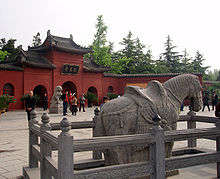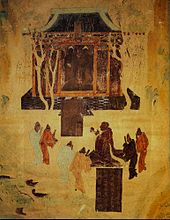This article is about Buddhist tradition of the Han Chinese. For the Buddhism native to Tibet, see Tibetan Buddhism.
| Part of a series on |
| Chinese Buddhism |
|---|
 |
At the peak of the Tang Dynasty's vitality, Chinese Buddhism produced numerous spiritual masters.[1][2] Scholars classified Chinese buddhism into 7-15 schools,[3][4][5] commonly into 10 schools(zh:汉传佛教十宗).
After the turmoil of the Cultural Revolution, Chinese Buddhism is growing again, ancient monasteries being rebuild and ordination restarted.[6]
[edit] Seven Warring States (481-221 BCE)
Main article: Seven Warring States
According to some European historians, Mauryan emperor Aśoka the Great sent the royal monk Massim Sthavira to Nepal, Bhutan, and China to spread Buddhism around 265 BCE. However, it has not been widely confirmed that these missionaries arrived in China or that they were responsible for establishing the teachings of Buddhism there.[edit] Qin Dynasty (221–206 BCE)
Main article: Qin Dynasty
Admitting the impossibility of saying "when or how the first Buddhist missions in China began", Kenneth Saunders mentions Ashoka and the Fayuan Zhulin (written 688 CE) noting missionaries arriving in Qin Dynasty (221–206 BCE) China. This Buddhist encyclopedia claims that in 217 BCE, the monk Li Fang 李防 and seventeen others arrived in Xi'an – but this legend is uncorroborated by historical sources.[7][edit] Han Dynasty (206 BCE–220 CE)
Main articles: Han Dynasty and Silk Road transmission of Buddhism

A Jiangnan funerary jar from ca. 250-300 AD, decorated with a row of Buddhas seated on lotus-petal thrones, said to be one of the earliest examples of Chinese Buddhist art.[8]
[edit] Earliest historical arrivals
Generations of scholars have debated whether Buddhist missionaries first reached Han China via the maritime or overland routes of the Silk Road. The maritime route hypothesis, favored by Liang Qichao and Paul Pelliot, proposed that Buddhism was originally practiced in southern China, the Yangtze River and Huai River region, where prince Ying of Chu (present day Jiangsu) was jointly worshipping the Yellow Emperor, Laozi, and Buddha in 65 CE. The overland route hypothesis, favored by Tang Yongtong, proposed that Buddhism disseminated eastward through Yuezhi and was originally practiced in western China, at the Han capital Luoyang (present day Henan), where Emperor Ming of Han established the White Horse Temple in 68 CE. Rong Xinjiang, a history professor at Peking University, reexamined the overland and maritime hypotheses through a multi-disciplinary review of recent discoveries and research, including the Gandhāran Buddhist Texts, and concluded:The view that Buddhism was transmitted to China by the sea route comparatively lacks convincing and supporting materials, and some arguments are not sufficiently rigorous. Based on the existing historical texts and the archaeological iconographic materials discovered since the 1980s, particularly the first-century Buddhist manuscripts recently found in Afghanistan, the commentator believes that the most plausible theory is that Buddhism started from the Greater Yuezhi of northwest India (present-day Afghanistan and Pakistan) and took the land roads to reach Han China. After entering into China, Buddhism blended with early Daoism and Chinese traditional esoteric arts and its iconography received blind worship.[9]
[edit] Traditional accounts

White Horse Temple, traditionally held to be at the origin of Chinese Buddhism.

Mogao Caves 8th-century mural depicting the pseudohistorical legend of Emperor Wu of Han worshipping "golden man" Buddha statues captured in 121 BCE.
The emperor then sent an envoy to Tianzhu (Southern India) to inquire about the teachings of the Buddha.[11] Buddhist scriptures were said to have been returned to China on the backs of white horses, after which White Horse Temple was named. Two Indian monks also returned with them, named Dharmarakṣa and Kaśyapa Mātaṅga.In olden days emperor Ming saw in a dream a god whose body had the brilliance of the sun and who flew before his palace; and he rejoiced exceedingly at this. The next day he asked his officials: "What god is this?" the scholar Fu Yi said: "Your subject has heard it said that in India there is somebody who has attained the Dao and who is called Buddha; he flies in the air, his body had the brilliance of the sun; this must be that god."[10]
An 8th century Chinese fresco at Mogao Caves near Dunhuang in Gansu portrays Emperor Wu of Han (r. 141–87 BCE) worshiping statues of a golden man; "golden men brought in 121 BCE by a great Han general in his campaigns against the nomads". However, neither the Shiji nor Book of Han histories of Emperor Wu mentions a golden Buddhist statue (compare Emperor Ming above).
[edit] The first translations
The first documented translation of Buddhist scriptures into Chinese occurs in 148 CE with the arrival of the Parthian prince-turned-monk An Shigao (Ch. 安世高). He worked to establish Buddhist temples in Loyang and organized the translation of Buddhist scriptures into Chinese, testifying to the beginning of a wave of Central Asian Buddhist proselytism that was to last several centuries. An Shigao translated Buddhist texts on basic doctrines, meditation, and abhidharma. An Xuan (Ch. 安玄), a Parthian layman who worked alongside An Shigao, also translated an early Mahāyāna Buddhist text on the bodhisattva path.Mahāyāna Buddhism was first widely propagated in China by the Kushan monk Lokakṣema (Ch. 支婁迦讖, active c. 164–186 CE), who came from the ancient Buddhist kingdom of Gandhāra. Lokakṣema translated important Mahāyāna sūtras such as the Aṣṭasāhasrikā Prajñāpāramitā Sūtra, as well as rare, early Mahāyāna sūtras on topics such as samādhi, and meditation on the buddha Akṣobhya. These translations from Lokakṣema continue to give insight into the early period of Mahāyāna Buddhism.
[edit] Early Buddhist schools
During the early period of Chinese Buddhism, the Indian early Buddhist schools recognized as important, and whose texts were studied, were the Dharmaguptakas, Mahīśāsakas, Kāśyapīyas, Sarvāstivādins, and the Mahāsāṃghikas.[12]The Dharmaguptakas made more efforts than any other sect to spread Buddhism outside India, to areas such as Iran, Central Asia, and China, and they had great success in doing so.[13] Therefore, most countries which adopted Buddhism from China, also adopted the Dharmaguptaka vinaya and ordination lineage for bhikṣus and bhikṣuṇīs. According to A.K. Warder, in some ways in those East Asian countries, the Dharmaguptaka sect can be considered to have survived to the present.[14] Warder further writes that the Dharmaguptakas can be credited with effectively establishing Chinese Buddhism during the early period:[15]
It was the Dharmaguptakas who were the first Buddhists to establish themselves in Central Asia. They appear to have carried out a vast circling movement along the trade routes from Aparānta north-west into Iran and at the same time into Oḍḍiyāna (the Suvastu valley, north of Gandhāra, which became one of their main centres). After establishing themselves as far west as Parthia they followed the "silk route", the east-west axis of Asia, eastwards across Central Asia and on into China, where they effectively established Buddhism in the second and third centuries A.D. The Mahīśāsakas and Kāśyapīyas appear to have followed them across Asia into China. [...] For the earlier period of Chinese Buddhism it was the Dharmaguptakas who constituted the main and most influential school, and even later their Vinaya remained the basis of the discipline there.

No comments:
Post a Comment